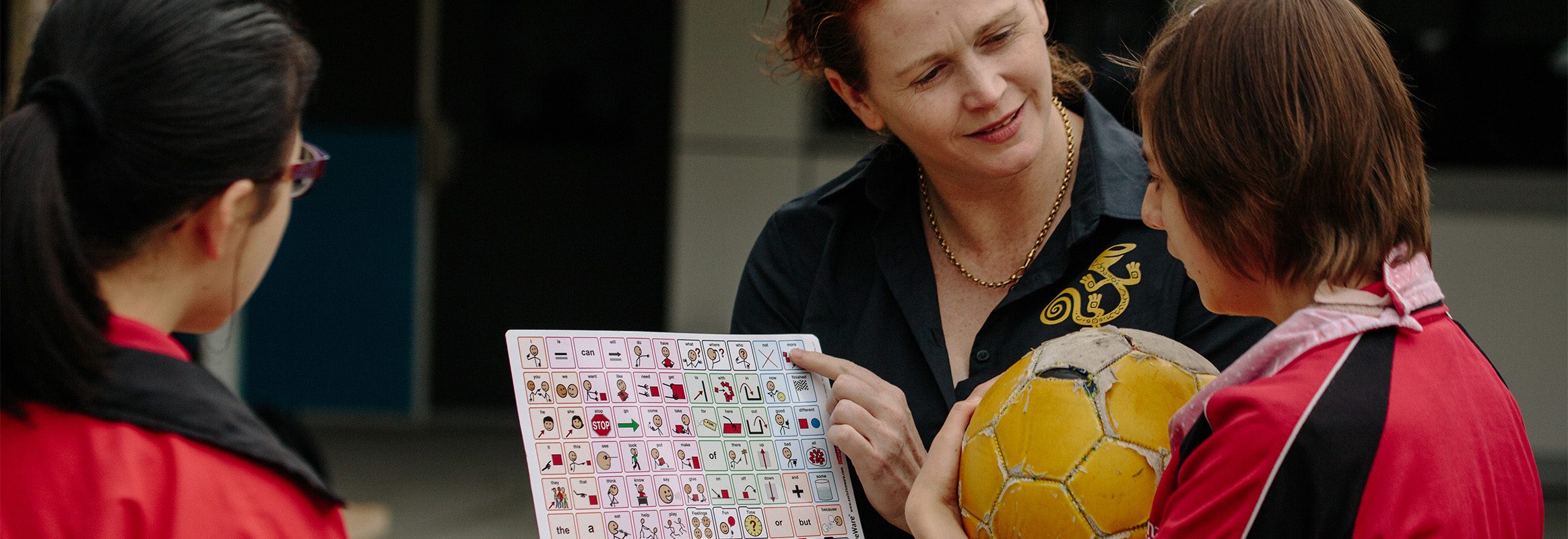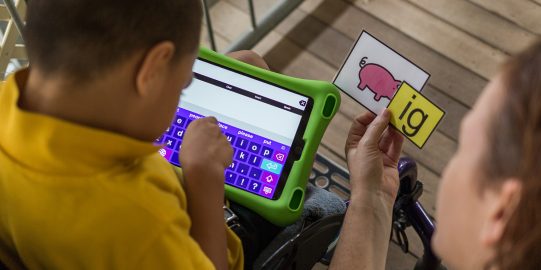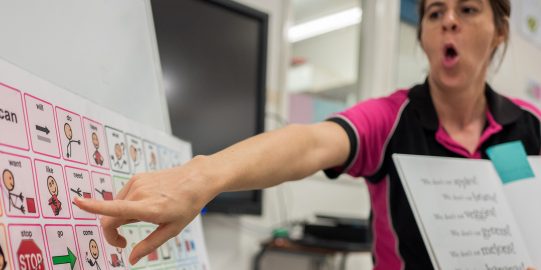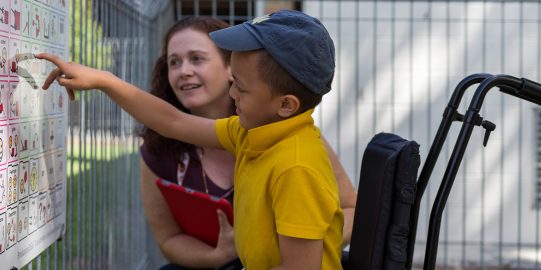Communication is always happening. This means there are always opportunities for modeling Augmentative and Alternative Communication (AAC), interacting and building language.
When we start out, making a plan for how AAC can be incorporated into the day can be beneficial. Without a plan, AAC may feel overwhelming.
This article will help us to look at where and when AAC can happen in a day. It will also consider how AAC is incorporated within routines, as well as adapting to unplanned activities and making changes as needed.
Where can AAC happen?
AAC can be used anywhere! Plan to take AAC with you wherever you go. Plan to make AAC available during any activity.
We may need to take into consideration the different environments where AAC will be used. Perhaps the communication device screen cannot be seen in bright sunlight. AAC devices may not always be water-proof, so how can communication happen in the pool or at the beach? How is the AAC device accessed if the AAC user’s hands are busy with something else, for example in bike-riding or horse-riding.
An alternative in these situations is to use paper-based examples of the AAC system, or to have systems strapped or fixed in easy to access locations.
It can also be important to plan for situations when AAC is not available. What strategies or tools can be put into place at these times?
5 ways to incorporate AAC
Build communication into your daily routines so that working on development of language and communication happens throughout the day.
1. Routines
One simple way to start AAC can be to look at everyday routines. What are some activities that happen during a day or week where AAC can be brought into it?
Perhaps the AAC user participates in making lunch every day. During this lunch preparation, there may be many opportunities to chat and discuss what you are doing. It may present opportunities to target particular words or phrases that are part of the AAC user’s current goals. For example, perhaps the AAC user is working on asking for help, so during lunch, you can model “help” when you cannot open the jar (“help open”), when you need the butter from the fridge (“help get”) or when you cannot find the cheese (“help look”), etc.
Routines can be an easy place to start, as often the language and communication is predictable and familiar. But don’t be afraid to shake routines up now and then! Lots of engagement and commenting can happen when things don’t quite go to plan, or are done differently.
Every routine should be looked at from time to time. What new words and ideas can we build in? How can we continue repetition of language but provide variety that ensures engagement? In the lunch example, it may mean trying new things to make for lunch, or going out for lunch, or inviting friends over for lunch.
Write a list of the common routine activities for an AAC user. How can AAC be incorporated? What language could be modelled during these activities? How will you extend and enhance the routine with chances to progress language over time?
2. Transitions
Looking at routines is just the start. The more often you consider where and when AAC can be incorporated in the day, the more occasions will arise. Soon you may find that as much communication and interaction happens in the transitions between activities as during the activities.
3. Plan for fun
Sometimes the best communication happens when we are having fun. When AAC users are motivated and engaged, there are more opportunities to interact and build language. Don’t wait for fun to happen - plan for it! Look at your routines and find extra ideas and tricks that can be brought into activities to make it fun.
4. Unplanned activities
Every now and then, things happen that we did not plan for. This will test both the team and the AAC user to find the words they need to communicate new messages in new situations. Look at it as a great challenge! You may make mistakes as you try to say different messages. The most important thing is that AAC is made available. There is no way to predict what awesome communication opportunities might arise.
5. Social interaction not testing
Building social interaction with AAC should always be a goal. AAC should be used to share news, to chat to friends and to engage in motivating and preferred activities and topics.
When AAC is used to test what someone knows, or to answer questions to assessment tasks, it may only make an AAC learner hate their AAC. AAC can be used to do school work, but it should not be the only time it is used.
Can you find time in your day where the focus is on building friendships and conversations, rather than testing or work?
Review plans
Plans will change over time and it is important to often review the ideas and strategies you have for AAC throughout the day. It is important to always plan for positive change for an AAC user, and this will mean changing and extending plans and goals regularly. You may come back to this step many times in your AAC journey.
The next step
Make a plan for AAC and stick to it! This is very important to keep everyone moving forward on the AAC journey. The more you integrate AAC into the day, the easier and more natural it becomes. Soon you will wonder how you ever did anything without AAC!
With the team on board and some plans in place, it's time to start communicating! A great place to start could be by modeling.
Links & References
- AssistiveWare Core Word Classroom. Planning for core words in activities. [Core word resources to download]
- Center of Literacy and Disability Studies. (November 2016). Embedding communication throughout the day.[Video]
- Hartmann, Amanda. Do’s and Don’ts of AAC - Access to AAC. [Blog post]
- Kent-Walsh, J., Stark, C., & Binger, C. (2008). Tales from school trenches: AAC service-delivery and professional expertise. Seminars in Speech and Language, 2, 146–154
- Page, Anne.(June 2017). Keep it fun, Keep it flexible, Keep it available: AAC in the Cloud. [Video]
- Sheldon, Erin. See me, see MY AAC. [Article]
- Zangari, Carole. (August 2017). 3 Tools for AAC planning. [Blog post]




